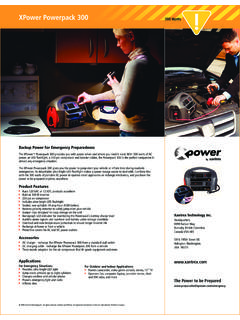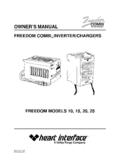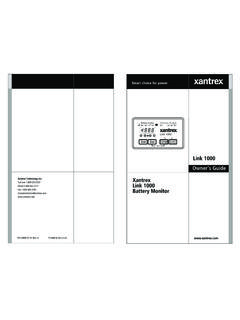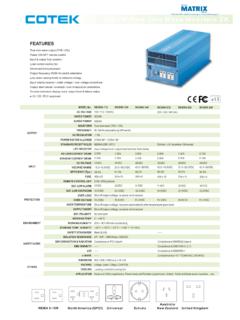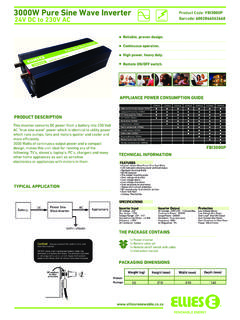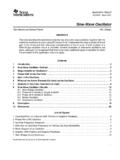Transcription of 1996, 1997 , 1998, 1999 Statpower Technologies Corporation.
1 PROwatt is a trademark of Statpower Technologies Corporation. Copyright 1996, 1997 , 1998 , 1999 Statpower Technologies rights of Contents1 How Your PROwatt 800 Principle of PROwatt 800 output Quick Power Test Where to Multiple and Charging Remote Outlets, Controls and Operating Common Troubleshooting Electrical IntroductionYour new PROwatt 800 inverter is a member of the most advanced line of DC to AC inverters available today. Itwill give you years of dependable service in your boat, RV, service vehicle or remote get the most out of your PROwatt 800, it must be installed and used properly.
2 Please read the installation andoperating instructions in this manual carefully before installing and using your PROwatt 800. Pay special atten-tion to the CAUTION and WARNING statements in this manual and on the PROwatt 800. CAUTION state-ments identify conditions or practices which could result in damage to your PROwatt 800 or to other statements identify conditions or practices that could result in personal injury or loss of How Your PROwatt 800 WorksAn inverter is an electronic device that converts low voltage DC (direct current) electricity from a battery or otherpower source to standard 115 volt AC (alternating current) household power.
3 In designing the PROwatt 800, Statpower has used power conversion technology previously employed in computer power supplies to give youan inverter that is smaller, lighter, and easier to use than inverters based on older Principle of OperationThe PROwatt 800 converts power in two stages. The first stage is a DC-to-DC converter which raises the lowvoltage DC at the inverter input to 145 volts DC. The second stage is the actual inverter stage. It converts thehigh voltage DC into 115 volts, 60 Hz DC-to-DC converter stage uses modern high frequency power conversion techniques that eliminate the bulkytransformers found in inverters based on older technology.
4 The inverter stage uses advanced power MOSFET transistors in a full bridge configuration. This gives you excellent overload capability and the ability to operatetough reactive loads like lamp ballasts and induction 1. Principle of PROwatt 800 output WaveformThe AC output waveform of the PROwatt 800 is called a "quasi- sine wave" or a "modified sine wave". It is astepped waveform that is designed to have characteristics similar to the sine wave shape of utility power. Awaveform of this type is suitable for most AC loads, including linear and switching power supplies used in elec-tronic equipment, transformers, and motors.
5 This waveform is much superior to the square wave produced bysome other DC to AC ! RECHARGEABLE APPLIANCESC ertain rechargers for small nickel cadmium batteries can be damaged if connected to the PROwatt. Twoparticular types of equipment are prone to this problem:1)small battery operated appliances such as flashlights, razors, and night lights that can be plugged di-rectly into an AC receptacle to )certain battery chargers for battery packs used in hand power tools. These chargers have aWARNING label stating that dangerous voltages are present at the battery NOT use the PROwatt with the above problem does not occur with the vastmajority of battery operated of this equipment uses a separatecharger or transformer that is plugged intothe AC receptacle and produces a low voltageoutput.
6 If the label on the AC adapter orcharger states that the adapter or charger pro-duces a low voltage AC or DC output (lessthan 30 volts), the PROwatt will have notrouble powering this charger or modified sine wave produced by the PROwatt 800 is designed to have a RMS (root mean square) voltage of115 volts, the same as standard household power. Most AC voltmeters (both digital and analog) are sensitive tothe average value of the waveform rather than the RMS value. They are calibrated for RMS voltage under the as-sumption that the waveform measured will be a pure sine wave.
7 These meters will not read the RMS voltage of amodified sine wave correctly. They will read about 2 to 20 volts low when measuring the output of the PROwatt800. For accurate measurement of the output voltage of the PROwatt 800, a true RMS reading voltmeter, suchas a Fluke 87, Fluke 27, Tektronix DMM249, or B&K Precision Model 391, must be 2. Modified sine Wave43 Quick CheckoutThis section will give you the information you need to quickly hook-up your PROwatt 800 and check its per-formance before going ahead with permanent installation. You will need the following:a) a 12 volt DC power source (24 volt for PW800/24)b) two cables to connect the power source to the PROwatt 800c) a test load that can be plugged into the AC receptacle on the PROwatt Power SourceThe power source must provide between 11 and 15 volts (22 and 30 volts for PW800/24) DC and must be able tosupply sufficient current to operate the test load.
8 As a rough guideline, divide the wattage of the test load by 10(by 20 for PW800/24) to obtain the current (in amperes) the power source must : Test load is rated at 250 watts. Power source must be ableto deliver 250 10 = 25 amperes (or amps for PROwatt 800/24).BatteryUse a fully-charged 12 volt (nominal) battery that can deliver the required current while maintaining its voltageabove 11 volts (22 volts for 24 volt battery system). A fully-charged (12 volt) automobile battery is capable ofdelivering up to 50 amperes without an excessive voltage Power SupplyUse a well regulated DC power supply that has an output voltage between 11 volts and 14 volts (22-28 volts forPW800/24) and can deliver the required current.
9 If the supply is adjustable, make sure that the output voltage isadjusted to be between 11 volts and 14 volts (22-28 volts for PW800/24). The inverter may shut down if thevoltage is outside these limits and may be damaged if the voltage is above 16 volts (32 volts for PW800/24).Also ensure that any current limit control is set so that the power supply can deliver the required CablesYour cables must be as short as possible and large enough to handle the required current. This is to minimize thevoltage drop between the power source and the inverter when the inverter is drawing current from the powersource.
10 If the cables introduce an excessive voltage drop, the inverter may shut down when drawing higher cur-rents because the voltage at the inverter drops below 10 volts (20 volts on PW800/24).We recommend #4 AWG (#6 AWG on PW800/24) stranded copper cable that is no longer than 4 ft ( m) ifyou want to test the PROwatt 800 to its maximum ratings. For short term testing at reduced power levels, theguidelines below should be followed:Test Load Power Minimum Cable SizeMinimum Cable SizeConsumption For PW800/12 voltPW800/24 voltShort Term Test100 watts #16 AWG copper#18 AWG copper250 watts #12 AWG copper#16 AWG copper500 watts #8 AWG copper#12 AWG copperIdeally, the cable should be no more than 4 ft ( m) end of the cable to be connected to the inverter must have its insulation stripped for about 1/2 inch ( cm)back from the end, exposing the bare copper conductor.


